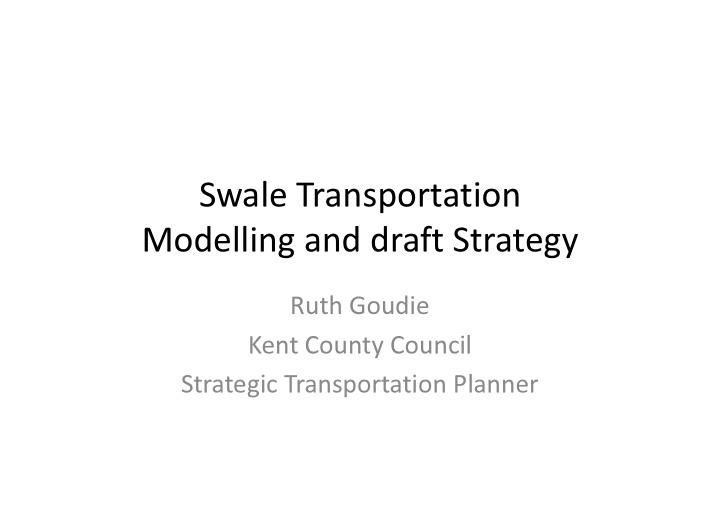



Swale Transportation Modelling and draft Strategy Ruth Goudie Kent County Council Strategic Transportation Planner
• Jacobs model 2010 • Covers Sittingbourne and A249 to Sheerness • Does not cover Faversham • M2 J5 is at edge of model area • Model was developed before SNRR and RRR • Opening of SNRR changed traffic patterns in model area • Model did not include a Do Minimum scenario • Model is suitable now for high level forecasts
• 2031 Do Minimum – background growth + completions + extant permissions • 2031 Do Something 1 – Do minimum + housing 540dpa + 600,000m 2 employment land • 2031 Do Something 2 -Do minimum + housing 740dpa + 600,000m 2 employment land • 2031 Do Something 1 + Bapchild link
Forecast additional travel demand in study zone Increase over base 160% 140% 120% 100% AM-origin PM-origin 80% AM-destination PM-destination 60% 40% 20% 0% DM 540dpa 740dpa
Forecast origin and destination of additional traffic in study area
M2 Junction 5 morning peak hour
M2 Junction 5 afternoon peak hour
Effect of Bapchild Link am
Effect of Bapchild Link pm
Conclusions • Growth targets for Swale can be accommodated in the transport network with mitigation at specific locations • Greater pressure on M2 J5 will require capacity improvements to accommodate development and background growth • No pure traffic need for Bapchild link, but it would remove some traffic from A2 east of Sittingbourne and in town centre
Draft Swale Transportation Strategy Headline Aim To transform Swale’s economic, social and environmental prospects
Themes of the Strategy Theme Aim Transportation issues Encouraging sustainable Encourage the use of sustainable Walking travel means of travel as an alternative Cycling to the private car Bus Rail Improvements to Removal of pinchpoints which are Intelligent Transport systems transport infrastructure barriers to development and Additional road capacity and growth. infrastructure improvements Alternative access to Reduce the need to travel and Sustainable mixed use services supporting independence developments Travel plans Road Safety Reduce the number of people Crash remedial measures killed or seriously injured on the Lower speeds designed into new district’s roads developments Road safety campaigns
Key Transport Challenges Congestion at M2 junction 5 acts a barrier to further development on Swale. • Capacity improvements required at A249 Key Street and Grovehurst interchanges • Rural areas of the borough are remote from main centres and less well served by • public transport Public transport tends to be inaccessible to the mobility impaired • Traffic congestion with school/ employment commuting into Sittingbourne, • causing rural rat-runs in the south of town, and air quality issues. Transport interchange between cycle routes, bus services, and train services is • poor, therefore encouraging the use of cars to rail stations, which add to problems with parking and congestion Not enough uptake of sustainable transport • No current parking strategy • Constrained viability of new developments to provide significant infrastructure • contributions.
Infrastructure Improvements • M2 Junction 5 • A249 Grovehurst Interchange • Sittingbourne Town Centre UTMC • Spirit of Sittingbourne scheme • A2/ A251 Faversham – traffic signal scheme • A2/ A249 Key Street • A2500 Lower Road traffic signal junction • Variable message signs for traffic information • Schemes to smooth traffic flow • SNRR extension to Bapchild • M2 link to Kent Science Park (longer term)
Targets 1. No increase in traffic flows at key locations 2. Reduce % of journeys to work by private car to 55% 3. Proposed mode share targets of other means of transport to increase 4. Buses meet timetables for 95% of time 5. Reduce KSI crashes by 50% 6. Reduce NO2 levels to below 40µg/m 3
Mode share targets Current Mode Target Mode Percentage Share Share Change Drive 65% 55% -15% Passenger 5.5% 8% +45% Train 6.9% 6.9% 0 Bus 2% 3% +50% Motorcycle 0.9% 0.9% 0 Cycle 2.2% 3% +36% Walk 11.3% 15% +33% Work from home 5% 7% +40% Other 1.2% 1.2% 0 Totals 100% 100%
Recommend
More recommend